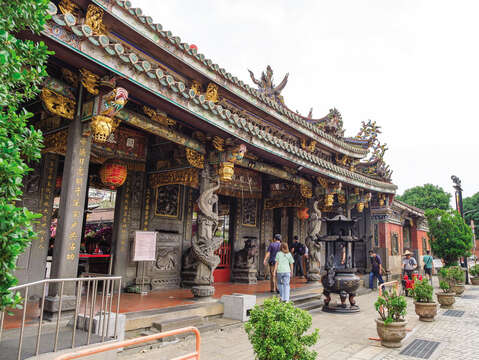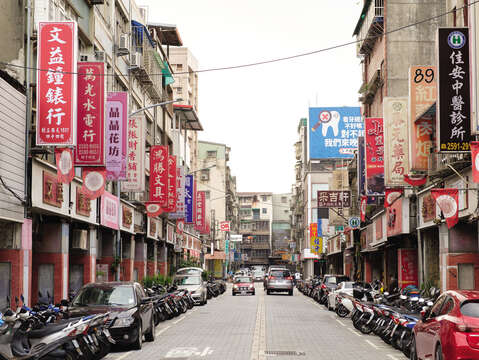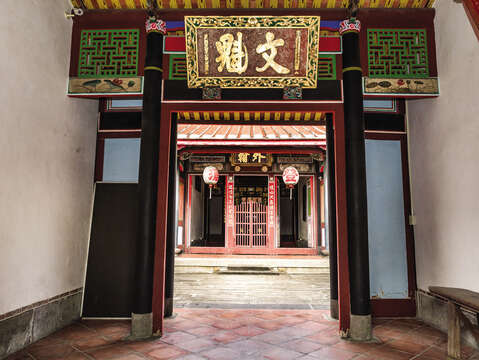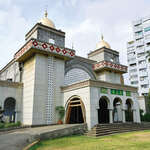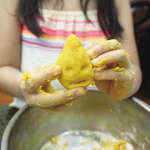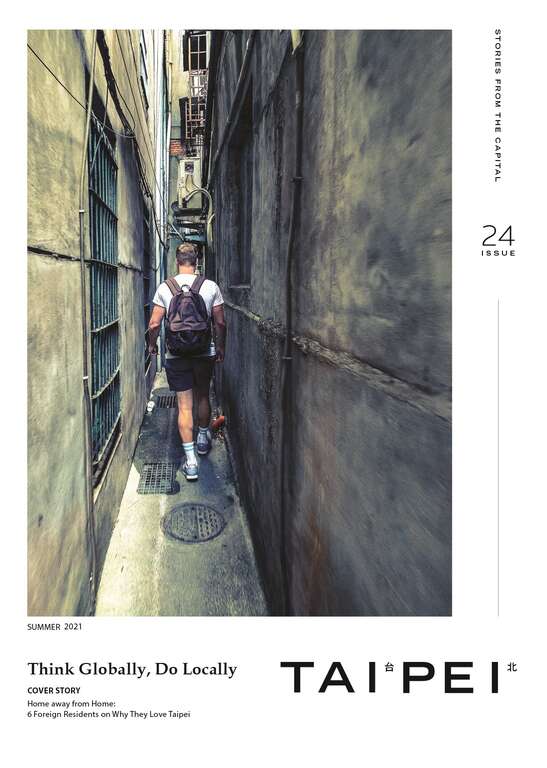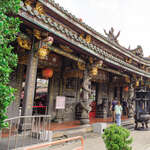Post date:2021-07-02
1364
TAIPEI #24 (2021 Summer)
Follow Old-School Taipeiers Through Dalongdong
Author: Yining Chen
Photographer: Yenyi Lin, Taiwan Scene Editor Joe Henley
Located at the junction of the Tamsui (淡水河) and Keelung Rivers, Dalongdong (大龍峒) was first settled by the Basay tribe (巴賽族) of the Plains Aborigines in northern Taiwan, and was once recorded as "Pourompon" during the period of Taiwan under Dutch rule. Even today, the Taiwanese pronunciation “Dalangpang (大浪泵)” still retains its ancient tones from centuries ago.
In the early Qing Dynasty, a large number of Han Chinese of Quanzhou Tongan (泉州同安) ancestry moved in, so it was called “Dalong Tong (大隆同),” which when literally translated means "Prosperous Tongan." Later, because of the large number of successful candidates in imperial examinations, locals believed that this place was a dragon cave that bestowed remarkable land and produced outstanding people, so it was called "Dalongdong" (Dragon Cave).
Deep Faith in “Blessing of Tongan” Drives Local Cultural Heritage
Like other settlements along the Tamsui River, such as Monga (艋舺) and Dadaocheng, Dalongdong was one of the first areas to develop in Taipei. During the Qing Dynasty, residents from Tongan in Quanzhou who moved to the area brought with them the belief in the Emperor Baosheng (保生大帝), the god of medicine, and built Baoan Temple (大龍峒保安宮) during the Qianlong reign (乾隆, 1735 A.D - 1796 A.D.) of the Qing Dynasty, so as to "Bless Tongan." More than two centuries have since passed, and yet the majestic and solemn Baoan Temple is still very much thriving, and has become an important center of faith that gives locals peace of mind.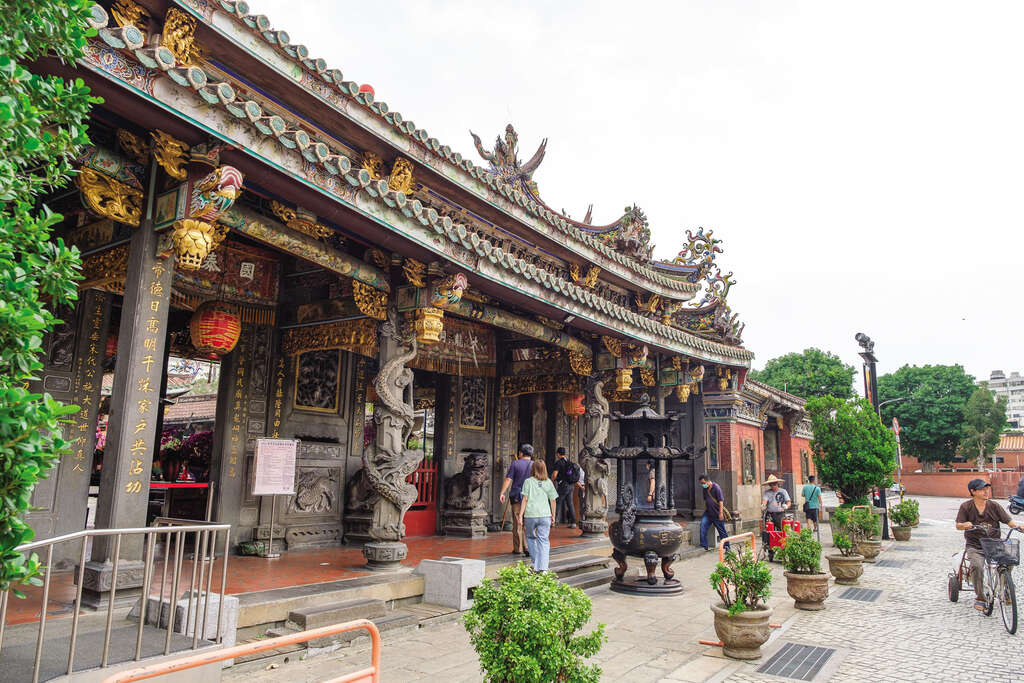 ▲Baoan Temple is the religious center for many locals in Taipei.
▲Baoan Temple is the religious center for many locals in Taipei.
The history and culture of Dalongdong has also developed along with Baoan Temple. The former site of Forty-Four Kan (四十四坎舊址) next to the temple was once the earliest planned road in Taipei. Local merchant families made full use of the leftover building materials from the construction of Baoan Temple to build two rows of wooden tiled shopping streets. Each store is of the same size, length and width, and this form of construction is known as “kan (坎).” Therefore, this road was aptly named Forty-Four Kan Street (四十四坎街) due to 22 shops sitting on either side.
Although the buildings on Forty-Four Kan Street were later demolished due to the widening of the road, there are still many old and simple signs left behind, including the one at the corner of the street, Zheng Yi Guo Yao Chinese Medicine Store (正一堂國藥號). When you get to the junction of Hami Street (哈密街) and Chongqing North Road (重慶北路), you will see the marker of the former “Dalongtong” gate on the ground, recording the former prosperity of the once thriving shopping street.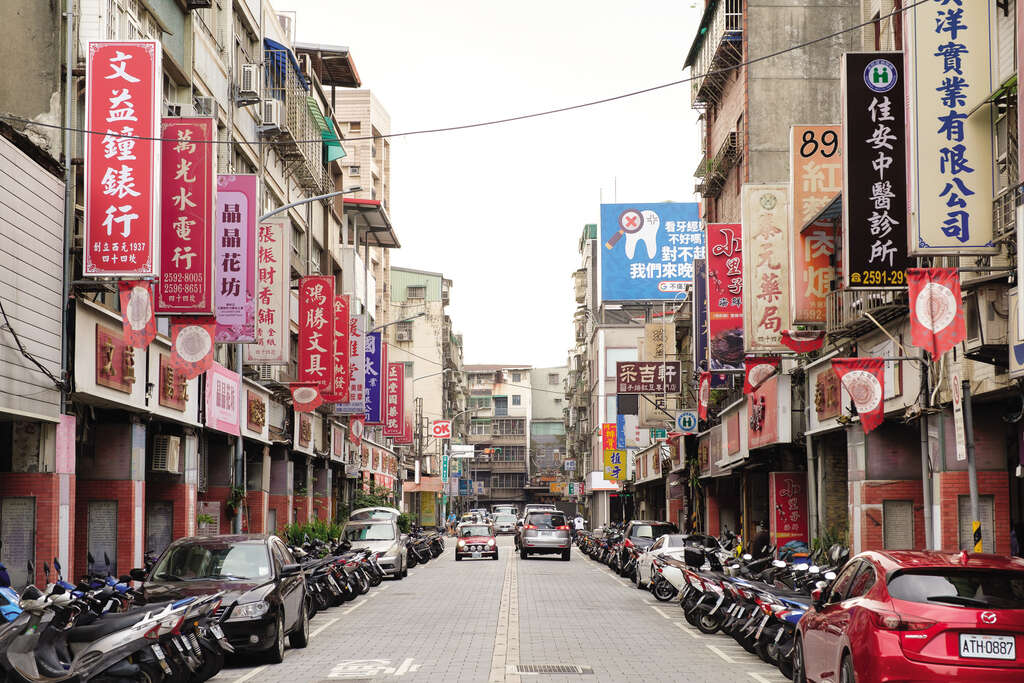 ▲Formally named Forty-Four Kan Street, the origins of well-organized Hami Street can be traced back to the Qing Dynasty.
▲Formally named Forty-Four Kan Street, the origins of well-organized Hami Street can be traced back to the Qing Dynasty.
Strong beliefs and culture surround Baoan Temple. The temple is also home to the only Golden Lion Troupe in Taiwan which has an “earless golden lion.” With a history almost as old as the temple itself, the Golden Lion Dance Group Ta-Long-Tong (大龍峒金獅團) started out as a lion dance troupe for civil defense needs, but later changed from a martial arts group into a lion dance troupe. The lion with missing ears symbolizes that it is not disturbed by gossip, but only focuses on its immediate skills and goals. This spirit has been with the lion dance culture for generations, and has taken root in Dalongdong.
Walk Through Taipei’s Earliest “Hipster” Paradise
The Chen family, which prospered along with the Forty-Four Kan Street, further established a deep cultural heritage in Dalongdong by building the Shuren Academy (樹人書院) during the Qing Dynasty and the Confucius Temple during the period of Japanese rule (1895-1945). The family’s ancestral home, the Chen Yueji Residence (陳悅記祖宅), is a well-known monument in Dalongdong.
Located in Section 4 of Yanping North Road (延平北路四段), the ancestral house of Chen Yueji, a Minnan-style courtyard home, was built in 1807 by Chen Xunyan (陳遜言), the first generation of the Chen family to prosper through business, on the banks of the Tamsui River. You can still see a pair of stone flagpoles outside the house, which are the only pair left in Taiwan today, honoring the achievements of the students who took and passed the imperial examinations.
The Chen family produced three juren (舉人, people who passed the provincial examination) in the Qing Dynasty, including Chen Weiying (陳維英), who became a government official and taught in many academies.
Because of the numerous talents he nurtured, he was known as an outstanding teacher in the area, so the Chen Yueji Residence was also called the “Teacher’s Residence (Laoshi Fu, 老師府).” The Residence is currently still partially used by the Chen family’s descendants, but from a distance, the partially renovated exterior of the house provides a glimpse of the many memories of the old Minnan-style mansion.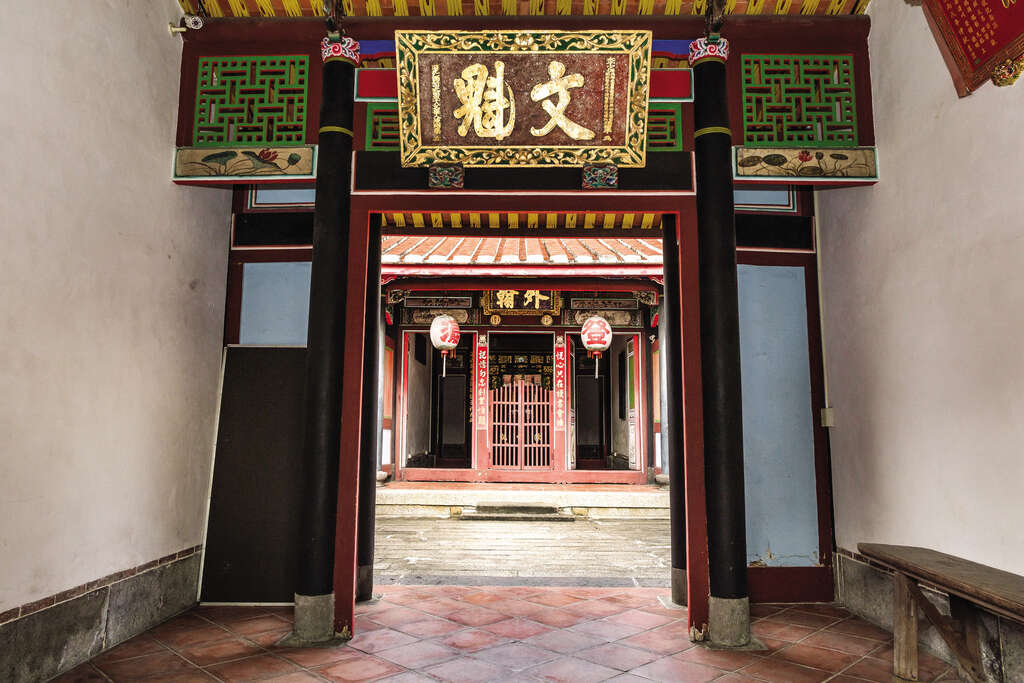 ▲Wooden inscribed boards marking the honor of the Chen family are still hanging inside the Chen Yueji Residence.
▲Wooden inscribed boards marking the honor of the Chen family are still hanging inside the Chen Yueji Residence.
Chen Weiying, a scholar who was concerned with education, established the Shuren Academy in Baoan Temple to impart knowledge to local youths, promote local culture, and enhance the literary atmosphere of Dalongdong. Later, Shuren Academy moved out of the Baoan Temple during Japanese rule and was relocated to the newly built Shuren Academy Wenchang Temple (樹人書院文昌祠), and even awarded scholarships to encourage students to cultivate talents. Nowadays, it has become a favorite temple among students to pray for good grades. Every year before major exams, you can see tables full of offerings, representing the sincerity of the students’ prayers for good luck.
The Chen Yueji Residence and Shuren Academy still bear witness to the educational and cultural depth of Dalongdong, which was also the earliest gathering place for literary and artistic youth in Taipei.
A Literary Family Promotes Confucian Temple and Confucianism in Taipei
The Chen family in Dalongdong was also a key driver in the creation of the Confucian Temple and imparting Confucianism in Taipei today. The earliest Confucius Temple in Taipei was built during the Qing Dynasty in the southern gate of the ancient Taipei City, but it was later demolished during Japanese rule and then rebuilt as the Taihoku Prefectural Taihoku First Girls’ High School on the same site (today’s Taipei First Girls High School and National Taipei University of Education).
During the midpoint of Japanese rule, the local gentry felt that the lack of a Confucian temple made it difficult to continue the Confucian tradition, and met to discuss the construction of another Confucian temple. At that time, the poet Chen Peigen (陳培根), a member of the Chen family, offered to donate his family’s land if the temple could be built in Dalongdong. The construction of the temple began in 1927, and in 1939 the entire complex was completed and became the Taipei Confucius Temple we see today.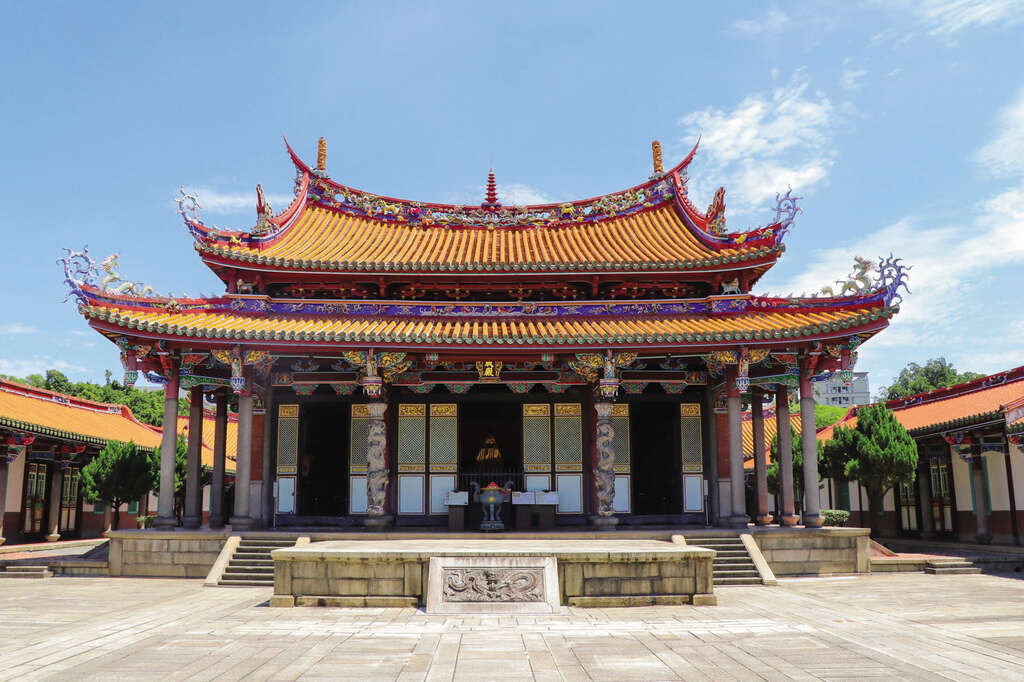 ▲Built during the 1920s and 1930s, Taipei Confucius Temple carries the legacy of Han Chinese culture that is rooted in old Taipeiers. (Photo/Taiwan Scene)
▲Built during the 1920s and 1930s, Taipei Confucius Temple carries the legacy of Han Chinese culture that is rooted in old Taipeiers. (Photo/Taiwan Scene)
The Taipei Confucius Temple is a further continuation of the Dalongdong area’s heritage regarding the transmission of Chinese culture, and it also allows us to explore the changes and development of the city of Taipei in the present day.
Although not as glamorous as Dadaocheng, which inherits the commercial atmosphere of old Taipei, we can still feel the warm atmosphere of art and culture in the quiet alleyways and serene temples of Dalongdong.
Follow Old-School Taipeiers Through Dalongdong
Author: Yining Chen
Photographer: Yenyi Lin, Taiwan Scene Editor Joe Henley
Located at the junction of the Tamsui (淡水河) and Keelung Rivers, Dalongdong (大龍峒) was first settled by the Basay tribe (巴賽族) of the Plains Aborigines in northern Taiwan, and was once recorded as "Pourompon" during the period of Taiwan under Dutch rule. Even today, the Taiwanese pronunciation “Dalangpang (大浪泵)” still retains its ancient tones from centuries ago.
In the early Qing Dynasty, a large number of Han Chinese of Quanzhou Tongan (泉州同安) ancestry moved in, so it was called “Dalong Tong (大隆同),” which when literally translated means "Prosperous Tongan." Later, because of the large number of successful candidates in imperial examinations, locals believed that this place was a dragon cave that bestowed remarkable land and produced outstanding people, so it was called "Dalongdong" (Dragon Cave).
Deep Faith in “Blessing of Tongan” Drives Local Cultural Heritage
Like other settlements along the Tamsui River, such as Monga (艋舺) and Dadaocheng, Dalongdong was one of the first areas to develop in Taipei. During the Qing Dynasty, residents from Tongan in Quanzhou who moved to the area brought with them the belief in the Emperor Baosheng (保生大帝), the god of medicine, and built Baoan Temple (大龍峒保安宮) during the Qianlong reign (乾隆, 1735 A.D - 1796 A.D.) of the Qing Dynasty, so as to "Bless Tongan." More than two centuries have since passed, and yet the majestic and solemn Baoan Temple is still very much thriving, and has become an important center of faith that gives locals peace of mind.
 ▲Baoan Temple is the religious center for many locals in Taipei.
▲Baoan Temple is the religious center for many locals in Taipei.The history and culture of Dalongdong has also developed along with Baoan Temple. The former site of Forty-Four Kan (四十四坎舊址) next to the temple was once the earliest planned road in Taipei. Local merchant families made full use of the leftover building materials from the construction of Baoan Temple to build two rows of wooden tiled shopping streets. Each store is of the same size, length and width, and this form of construction is known as “kan (坎).” Therefore, this road was aptly named Forty-Four Kan Street (四十四坎街) due to 22 shops sitting on either side.
Although the buildings on Forty-Four Kan Street were later demolished due to the widening of the road, there are still many old and simple signs left behind, including the one at the corner of the street, Zheng Yi Guo Yao Chinese Medicine Store (正一堂國藥號). When you get to the junction of Hami Street (哈密街) and Chongqing North Road (重慶北路), you will see the marker of the former “Dalongtong” gate on the ground, recording the former prosperity of the once thriving shopping street.
 ▲Formally named Forty-Four Kan Street, the origins of well-organized Hami Street can be traced back to the Qing Dynasty.
▲Formally named Forty-Four Kan Street, the origins of well-organized Hami Street can be traced back to the Qing Dynasty.Strong beliefs and culture surround Baoan Temple. The temple is also home to the only Golden Lion Troupe in Taiwan which has an “earless golden lion.” With a history almost as old as the temple itself, the Golden Lion Dance Group Ta-Long-Tong (大龍峒金獅團) started out as a lion dance troupe for civil defense needs, but later changed from a martial arts group into a lion dance troupe. The lion with missing ears symbolizes that it is not disturbed by gossip, but only focuses on its immediate skills and goals. This spirit has been with the lion dance culture for generations, and has taken root in Dalongdong.
Walk Through Taipei’s Earliest “Hipster” Paradise
The Chen family, which prospered along with the Forty-Four Kan Street, further established a deep cultural heritage in Dalongdong by building the Shuren Academy (樹人書院) during the Qing Dynasty and the Confucius Temple during the period of Japanese rule (1895-1945). The family’s ancestral home, the Chen Yueji Residence (陳悅記祖宅), is a well-known monument in Dalongdong.
Located in Section 4 of Yanping North Road (延平北路四段), the ancestral house of Chen Yueji, a Minnan-style courtyard home, was built in 1807 by Chen Xunyan (陳遜言), the first generation of the Chen family to prosper through business, on the banks of the Tamsui River. You can still see a pair of stone flagpoles outside the house, which are the only pair left in Taiwan today, honoring the achievements of the students who took and passed the imperial examinations.
The Chen family produced three juren (舉人, people who passed the provincial examination) in the Qing Dynasty, including Chen Weiying (陳維英), who became a government official and taught in many academies.
Because of the numerous talents he nurtured, he was known as an outstanding teacher in the area, so the Chen Yueji Residence was also called the “Teacher’s Residence (Laoshi Fu, 老師府).” The Residence is currently still partially used by the Chen family’s descendants, but from a distance, the partially renovated exterior of the house provides a glimpse of the many memories of the old Minnan-style mansion.
 ▲Wooden inscribed boards marking the honor of the Chen family are still hanging inside the Chen Yueji Residence.
▲Wooden inscribed boards marking the honor of the Chen family are still hanging inside the Chen Yueji Residence.Chen Weiying, a scholar who was concerned with education, established the Shuren Academy in Baoan Temple to impart knowledge to local youths, promote local culture, and enhance the literary atmosphere of Dalongdong. Later, Shuren Academy moved out of the Baoan Temple during Japanese rule and was relocated to the newly built Shuren Academy Wenchang Temple (樹人書院文昌祠), and even awarded scholarships to encourage students to cultivate talents. Nowadays, it has become a favorite temple among students to pray for good grades. Every year before major exams, you can see tables full of offerings, representing the sincerity of the students’ prayers for good luck.
The Chen Yueji Residence and Shuren Academy still bear witness to the educational and cultural depth of Dalongdong, which was also the earliest gathering place for literary and artistic youth in Taipei.
A Literary Family Promotes Confucian Temple and Confucianism in Taipei
The Chen family in Dalongdong was also a key driver in the creation of the Confucian Temple and imparting Confucianism in Taipei today. The earliest Confucius Temple in Taipei was built during the Qing Dynasty in the southern gate of the ancient Taipei City, but it was later demolished during Japanese rule and then rebuilt as the Taihoku Prefectural Taihoku First Girls’ High School on the same site (today’s Taipei First Girls High School and National Taipei University of Education).
During the midpoint of Japanese rule, the local gentry felt that the lack of a Confucian temple made it difficult to continue the Confucian tradition, and met to discuss the construction of another Confucian temple. At that time, the poet Chen Peigen (陳培根), a member of the Chen family, offered to donate his family’s land if the temple could be built in Dalongdong. The construction of the temple began in 1927, and in 1939 the entire complex was completed and became the Taipei Confucius Temple we see today.
 ▲Built during the 1920s and 1930s, Taipei Confucius Temple carries the legacy of Han Chinese culture that is rooted in old Taipeiers. (Photo/Taiwan Scene)
▲Built during the 1920s and 1930s, Taipei Confucius Temple carries the legacy of Han Chinese culture that is rooted in old Taipeiers. (Photo/Taiwan Scene)The Taipei Confucius Temple is a further continuation of the Dalongdong area’s heritage regarding the transmission of Chinese culture, and it also allows us to explore the changes and development of the city of Taipei in the present day.
Although not as glamorous as Dadaocheng, which inherits the commercial atmosphere of old Taipei, we can still feel the warm atmosphere of art and culture in the quiet alleyways and serene temples of Dalongdong.
Gallery
:::
Popular articles
 In Taipei, Touching Stories Behind Islamic Rituals (TAIPEI Quarterly 2021 Summer Vol.24)
In Taipei, Touching Stories Behind Islamic Rituals (TAIPEI Quarterly 2021 Summer Vol.24) Follow Old-School Taipeiers Through Dalongdong (TAIPEI Quarterly 2021 Summer Vol.24)
Follow Old-School Taipeiers Through Dalongdong (TAIPEI Quarterly 2021 Summer Vol.24) A Summer of Family Fun: Cooking with Your Kids (TAIPEI Quarterly 2021 Summer Vol.24)
A Summer of Family Fun: Cooking with Your Kids (TAIPEI Quarterly 2021 Summer Vol.24) Respecting the Aesthetics of Local Ingredients: The Spirit of Slow Food Alive and Well in the City (TAIPEI Quarterly 2021 Summer Vol.24)
Respecting the Aesthetics of Local Ingredients: The Spirit of Slow Food Alive and Well in the City (TAIPEI Quarterly 2021 Summer Vol.24) A Chocolate Full of Love from Taipei (TAIPEI Quarterly 2021 Summer Vol.24)
A Chocolate Full of Love from Taipei (TAIPEI Quarterly 2021 Summer Vol.24) The Philosophy of Hotel Management and Lifestyle (TAIPEI Quarterly 2021 Summer Vol.24)
The Philosophy of Hotel Management and Lifestyle (TAIPEI Quarterly 2021 Summer Vol.24)
 Follow Old-School Taipeiers Through Dalongdong (TAIPEI Quarterly 2021 Summer Vol.24)
Follow Old-School Taipeiers Through Dalongdong (TAIPEI Quarterly 2021 Summer Vol.24)